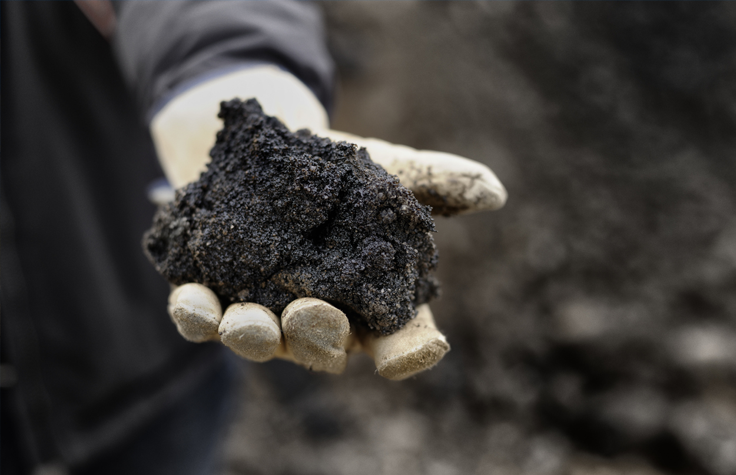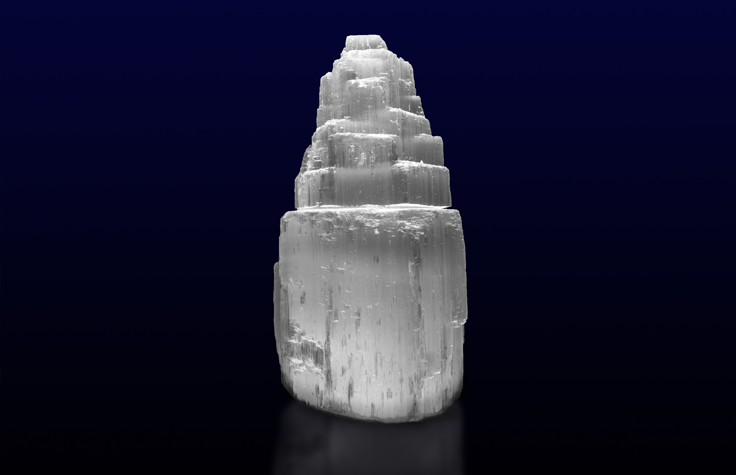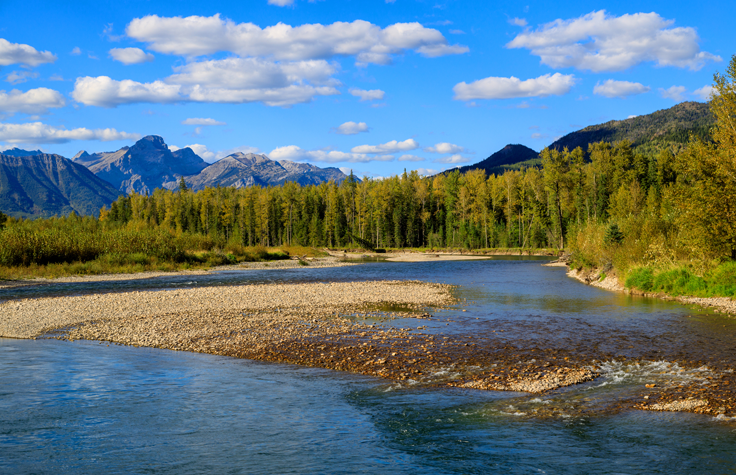
October 19, 2023
Selenium, element 34 on the periodic table, is essential for animal cell function—in small amounts. But just like oxygen and water, a high-enough concentration of selenium can become toxic.
Selenium occurs naturally in coal deposits and sulfide ores, like brassy chalcopyrite and crystalline sphalerite, which are important resources for copper and zinc mining. The mining process creates leftover rock, and water from rain or snowmelt that flows through this rock can carry selenium into nearby waterways. Plankton absorb the element directly into their tissues, and fish that feed on that plankton can potentially get enough selenium in their bodies to cause growth defects. It’s incumbent upon the mining industry, then, to find innovative ways to manage selenium and protect fish populations in the communities where it operates.
Renewable energy needs mining
For generations, the metals and minerals that the mining industry produces have been integral to improving quality of life. And the industry is on the cusp of a staggering increase in demand for materials critical for low-carbon and renewable energy technology.
“What we’re producing are the fundamental building blocks of society,” says Bryan Rairdan, technical director of processing at Teck Resources Limited, which has mining operations in Canada, the United States, Peru, and Chile. “With current technology, if we want to densify cities, we need steel. If you need steel, you need steelmaking coal. If you want to electrify the world, the best way we have to move those electrons around is copper.”
A single wind turbine requires 4.7 tons of copper and 335 tons of steel—and to meet net-zero emissions goals from now until 2050, the world will need as much copper as humanity has mined since 1900. Considering that mining is crucial to building green energy infrastructure, what can the industry do to advance its environmental performance?

Tiny creatures can have a big impact
As it turns out, some bacteria can “eat” selenium—or rather, their carbon metabolism has evolved to convert the element from its dissolved state into a more solid form, which is then easier for humans to keep out of the water cycle.
At its steelmaking coal mines in the Elk Valley of British Columbia, Teck has built “saturated rock fills,” which are large pits of waste rock allowed to fill with groundwater and treated with these special bacteria to reduce selenium levels in the watershed.
Teck’s water treatment facilities, including its saturated rock fills, are working. This treatment is removing between 95% and 99% of the selenium from treated water, and monitoring shows that selenium concentrations downstream of treatment have stabilized and are reducing.
Microbes can make mining itself more environmentally friendly, too. While most copper is obtained through furnace smelting, which contributes to air and water pollution, about 20% of the world’s copper now comes from hydrometallurgy, which uses strong acids and, increasingly, bacteria that can naturally leach the metal.
Bill Burton, principal geological/geotechnical engineer and H3 R&D lead at BGC Engineering, says the potential for microbial applications in mining is exciting. “There’s a goal in the industry for mining to be a temporary use of the land. You have to manage the waste and byproducts that come from the process, and there are many places where microbial biotechnology can help with that.”
For example, Rio Tinto, a mining company operating on six continents, has supported multiple R&D projects to find biotechnological ways to recover metals from mine-influenced water. And Elizabeth Deyett, senior bioinformatics scientist at Allonnia, explains that some microbes can be used to help dust suppression by binding fine sand particles together, making the air safer to breathe; others can be used to help mining companies extract certain metals they weren’t looking for before, like rare earth elements that are essential to many green technologies, such as energy-efficient light bulbs and hybrid vehicle batteries.
How many other kinds of industry-changing organisms might be lurking beneath our feet? To find out, we must seek genetic data from the earth itself.

The Mining Microbiome Analytics Platform
To discover and implement these organisms, the Canadian government’s Digital Supercluster initiative has formed the cross-industry Mining Microbiome Analytics Platform (M-MAP). Teck, BGC Engineering, Rio Tinto, and Allonnia are participating, as well as the Centre for Excellence in Mining Innovation, Koonkie Canada, Genome BC, and the University of British Columbia.
The partnership’s goal is to extract DNA from 15,000 mine site water, rock, and soil samples, sequence it, and create an online platform for storing and analyzing the data. “M-MAP is trying to get ahead of the curve,” Rairdan explains. “As opposed to saying, ‘We know these organisms do this,’ we’re looking ahead and asking, ‘What organisms are out there and what are they doing?’ We don’t know exactly what we’re going to find, but we know that the data set doesn’t currently exist.”
Koonkie CEO Aria Hahn describes it this way: “At the end of every PhD defense, the classic question is, ‘If you had unlimited resources and time, what would you do?’ M-MAP is essentially a manifestation of those answers. We have the people, the volume of data, the access to resources, and the expertise to solve big problems and make big discoveries.”
Generating and interpreting the data
No one member of M-MAP could accomplish the partnership’s goals alone. Teck and Rio Tinto are providing access to samples from their mine sites around the world, and Illumina systems are generating the raw DNA sequence data from these samples. Burton says that 20 years ago, sequencing of a single soil sample would’ve cost hundreds of thousands of dollars: “Now we’re doing it for hundreds. The technology to do this better wasn’t feasible until the innovation that came out of Illumina. It’s opening the door to a whole new world for us.”
For this project, Illumina is using both amplicon sequencing, which targets short fragments of DNA, and metagenomics, which analyzes the entire community of microbes in a sample. The sequencing has just begun, but it’s already proven revelatory. “Of the first 100 whole genomes we’ve been able to capture from mine sites, about 80 percent of them have been novel,” Hahn says. “So we’re looking at a lot of discovery here.”
The bioinformaticians of Koonkie take the raw sequence data and turn it into something usable. “We’re responsible for taking those As, Ts, Gs, and Cs and asking, ‘Who’s there? Who’s doing what?’” Hahn says. Their proprietary statistical software finds the meaningful signals among the noise and annotates them, hanging spotlights on the genes, both documented and novel, that seem like the best targets for genetic engineering and synthetic biology development.

Building better bacteria
In some cases, M-MAP may find organisms that are already perfectly suited for a job in the mines. One of Allonnia’s previous discoveries was a naturally occurring bacteria that processes 1,4-dioxane (a cosmetics industry byproduct that contaminates groundwater) into mere CO2 and H2O.
In other cases, nature might need a little help getting ready for the workforce—for example, a gene that’s useful for processing toxic waste might be found in a microbe that’s harmful to humans. That’s when Allonnia can wield the awesome power of genetic engineering to extract the beneficial gene and transport it into a different microbe that’s known to be harmless.
“There are ways to put selective pressure on organisms so it’s beneficial to them to keep that gene,” Deyett summarizes; “they’ll keep it and pass it on to future generations.” Et voilà, a new living tool is born. “When a lot of people think of the microbiome, they think of human health. But I think there's actually a lot more potential for microbes to help us in environmental settings.”
Leaving no trace
Once the mining is done and its byproducts processed, there’s one last vital step to reducing the industry’s environmental impact: remediating closed mines. As principal advisor for mine closure R&D at Rio Tinto, this is Nick Gurieff’s specialty.
“In Australia, the US, and Canada, there are tens if not hundreds of thousands of abandoned mine sites of all different sizes,” he says. “They’ve been there for many years, and they’re still polluting the local water and townships around them. Rio Tinto takes very seriously our responsibility to ensure that every one of our closed or legacy sites is rehabilitated to a standard that we’re happy with and—more importantly—the local communities are happy with.”
Contemporary mining companies are sensitive to the resistance their industry faces among the communities who are directly impacted—they know they must ensure that the land is suitable for use by future generations. Rio Tinto’s remediation process takes into account everything needed to restore the land: starting from demolition and removal of old structures and equipment, to remediating any waste, to replenishing the site’s native plant species and fertile topsoil.
“Topsoil remediation is one of the biggest challenges we have,” Gurieff admits. Soil microbiome is highly particular to its region of origin, and fully restoring it means knowing what was there in the first place. “We really need to understand what microbes are doing what. How can we enrich for certain microbes? How can we support our R&D project partners by giving them access to the unique microbes we have at our sites? All the information we get through M-MAP plays an important role in understanding how we could be doing more with what we have.”
Good stewards of the earth, both large and small
Our relationship with the microcosmos is undergoing a paradigm shift as great as when we first discovered it in the 17th century. We spent 300 years believing microbes were either ubiquitous but harmless stowaways or disease agents to be eradicated at all costs. Now we’re finally starting to explore the ways these tiny-but-mighty creatures could help us tackle some of our biggest challenges.
“It’s really easy to focus on the world we can see,” Deyett says. “But the more I learned about microbes, the more I learned that this is their planet. They’re responsible for its maintenance and health. They were here long before us and they’ll be here long after us, so to understand them is to understand what has given life to everything we see.”


